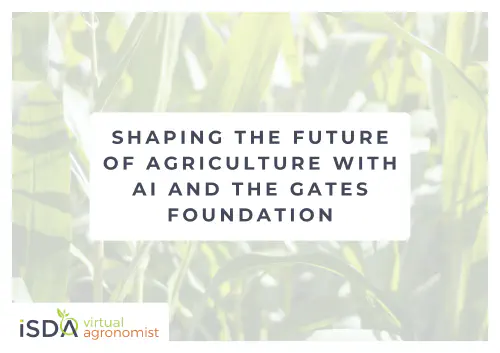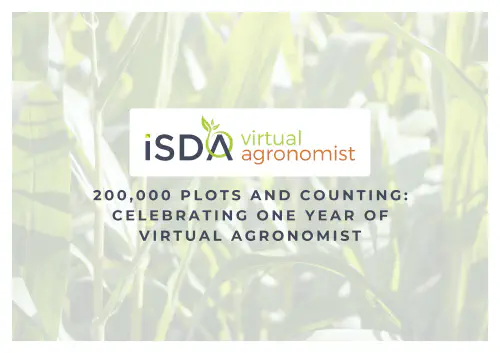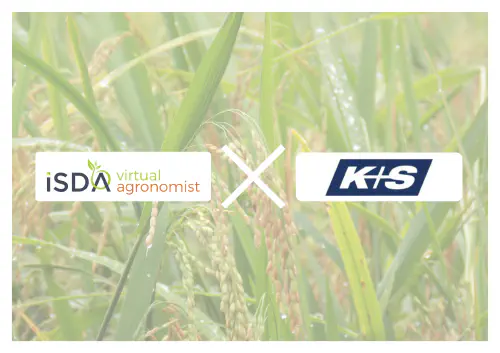Notes from the Special symposium on Translating Visionary Science for Excellence in African Agronomy at The American Society of Agronomy (ASA), the Crop Science Society of America (CSSA), and the Soil Science Society of America (SSSA) International Annual Meeting. 10th to 11th November 2020.
View the recorded videos from the conference.
African soils at 30-m resolution. A breakthrough for low-cost agronomic advisory.
Presented by Achim Dobermann. Chief Scientist, International Fertiliser Association.
In recent years there has been growing interest in, and a business case for investment in soil health throughout Africa. There has been a desire to create a digital soil map of Africa, and indeed the whole world, for decades. Only recent technological advances are now making it a possibility, particularly at this high resolution.
iSDAsoil is freely available through the website, and you can also find the technical information explaining the background and method used to create the map.
This is not a “one-off”. New data can be added, and the map updated rapidly and regularly.
We want to make a particular call to the entire community of researchers in the public and private sector to share additional data with us so that we can improve this product as a public good for everyone to use. We encourage everyone with available soil data and other ideas to contribute - Achim Doberman
Applications
Target interventions and investments based on soil constraints to crop production and nutrition, e.g.
- Closing yield gaps
- Climate change adaptation
- Preventing soil degradation
- Liming (from pH data)
- Malnutrition and health
- Fertiliser needs and policies
- Fertiliser products and blends
- Agronomic advisory services
- And more…
One of the fundamental problems in Africa is that for many decades the farming activities remove more nutrients from the soil than is put back. Manure and other fertilisation methods have not been enough, and the land has been further exploited through mining and other actions. This limits future crop yields.
We hope that this data and this tool will be used in the public and private sector to quickly develop strategies and concrete solutions for regional and local fertiliser recommendations. We hope that is can be used as the basis for more risk-based economic management, developing decision analytics solutions and assessment of risks related to investments.
iSDAsoil interactive session at the ASA-CSSA-SSSA International Annual Meeting
Hosted by Jonathan Crouch (CEO, iSDA) with contributions from Matt Miller (Lead Data Scientist, iSDA), Jamie Collinson (CTO, iSDA), and Keith Shepherd (Head of Diagnostics and Decision Science, iSDA). The Panel comprised Ranveer Chandra (Chief Scientist, Microsoft Azure Global), Christy van Beek (Director, SoilCares Foundation and Chief Agronomist, AgroCares), and Nathan Price (Crop and Agronomy Director, Yara).
Matt Miller introduced and demonstrated iSDAsoil. The background to how the resource was created, and further technical information can be found throughout the iSDA website.
Collecting and analysing the data
One of the major data gaps has been soil data. Particularly at the high resolution of iSDAsoil. The future of data-driven agriculture is thinking at the level of the individual farm. To display the uncertainty is a great step forward in transparency of the data, which is often missing from other tools. iSDA has taken a significant step in this field to address the broader goal of data-driven agriculture - Ranveer Chandra
It’s now all about “data”. “Combining data from different laboratories and sources can be very difficult, how do you standardise the different laboratories?” asked Christy van Beek. Usually, the more samples the better, responds iSDA, but the more datasets you include are subject to more variability. Many of the data points were from similar projects and labs for whom we had previously done cross-comparison. We used harmonising methods based on literature. We have done as much as we can to reduce errors and to harmonise the data. Questioning of the value of soil analysis has been due to the variation in results across labs. We are addressing this in some of our pilots using infrared spectroscopy, which is very reproducible. This data can be coupled with a new initiative to provide a Global Soil Spectral Calibration Library and Estimation Service, being developed under the Global Soil Laboratory Network of the Global Soil Partnership of FAO.
Using iSDAsoil
In-field analytics are not available and are un-economic in certain areas, says Nathan Price. This is a great add-on to field work as well as remote advisory. Being able to drill-down into specific sites, and being able to see the uncertainty models, aids decision making. There will be applications in food security, informing decisions about land capabilities and soil management.
Taking a static dataset to a visual and predictive model is potentially a game-changing advance for site-specific soil management within Africa. While the accuracy is potentially not where we want it to be from a scientific perspective, this is a significant step in the right direction as many corporate, government, agronomists and farmers are looking for data to make better informed decisions - Nathan Price
Of particular interest to Yara, continues Nathan, will be looking at the cultural practices on soil carbon sequestration, which you can map visually. The most limiting factors for crop production are related to the FCC classifications, which are displayed on iSDAsoil. The most exciting thing is to scale up advisory to reach more smallholders.
Bringing the information to the farmers
Farmers don’t tend to sign up to download and implement an API, they just want answers on the spot through a trusted advisor, comments Christy van Beek. How do you actually bring this to the farmer? “Continuous improvement” is our motto, says Jonathan Crouch, both at the ground level, and through analytics. Building a community and building relationships, in order to bring this information to the right place at the right time.
Having the data is only one step in getting the farmer to understand and to be given recommendations. What comes next is the behavioural change where you want to introduce different fertiliser or soil management practices - Christy van Beek
We are partnership based, continues Johnathan Crouch, and we will need to build on these to partner with people who have very strong networks with smallholders on the ground. Those who have a history of translating the data into adoptable advice and practices.
Do we think that digital solutions will replace the need for agronomists and extension agents? No. We think site-specific expert knowledge will always be important. We believe that digital tools will enable that expert knowledge to be shared with a larger number of farmers at a lower price point.
Updating the data and map
The frequency and nature of the updates will be driven by user interest. We want to see where we can improve it from the community, both scientific and commercial. We would like more data from the field, and better data. The ideal scenario is a self-improving loop.
Improved resolution is great – but what about improved accuracy? What we have generally seen from the history of soil mapping is that the model accuracy does improve, especially when incorporating geospatial variability in properties seen on the ground and including high-resolution covariates. This is a first attempt, so additional data will improve the accuracy further.
Commercial areas of interest
As a social enterprise, we at iSDA believe that making the resource freely available will generate more value and new innovations. We will develop tailored solutions built on this data that offer win-win value creation opportunities for agribusinesses and smallholders.
iSDAsoil will form the core of our advisory products, beginning with low cost “virtual soil scan” fertiliser recommendations, which are currently in field trials.
A key constraint to credit is having good enough access to data for lenders to make decisions. We are already seeing soil analysis applications for farm-focused loans where yield predictions are a key part of understanding production risk.
Future improvements
At the moment you can find data point by point, or by downloading the full dataset. Later when combined with the Google Earth engine, the data can be queried on arbitrary areas. Allowing for local or regional analysis. We are interested in hearing from the users to ensure we are developing it in a way which makes sense to the community.
While our current focus is Africa, there’s no reason why the same technology can’t be applied to other areas. We will be very happy to contribute knowledge from this project to assist others in further geographic areas.
Get involved
We encourage data sharing, and institutions donating data. We are interested in what people are building with the data and how they are using the API. If a feature is missing, talk to us about it.
How can I keep up to date? Sign up for our newsletter via our homepage for detailed updates, and follow us on Social media @iSDAAfrica.
About the Panel
Ranveer Chandra,Chief Scientist, Microsoft Azure Global. FarmBeats program.
FarmBeats is a platform to bring different datasets together; from sensors, drones, equipment, etc. allowing tools to be built on top. It is designed for researchers and agricultural technical companies. Through partnerships they build tools to implement the data into practices.
Christy van Beek, Director, SoilCares Foundation and Chief Agronomist, AgroCares.
AgroCares is an agro-tech company in The Netherlands who have created a handheld Bluetooth device for on-the-spot soil testing. A similar tool is in development for testing livestock feed. The testing is done through partners and their network of farmers. Customisation is possible where there are specific requirements.
Nathan Price, Crop and Agronomy Director, Yara.
Crop Knowledge and Agronomy Lead, Asia and Africa at Yara International, a leading fertilizer company with interests in environmental solutions to address global challenges.



